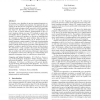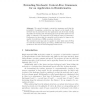209 search results - page 28 / 42 » Using Decision Trees for Agent Modeling: Improving Predictio... |
CEC
2009
IEEE
13 years 10 months ago
2009
IEEE
—When performing predictive data mining, the use of ensembles is known to increase prediction accuracy, compared to single models. To obtain this higher accuracy, ensembles shoul...
POPL
2011
ACM
12 years 10 months ago
2011
ACM
We describe a new algorithm for proving temporal properties expressed in LTL of infinite-state programs. Our approach takes advantage of the fact that LTL properties can often be...
BMCBI
2008
13 years 7 months ago
2008
Background: Mixture models of mutagenetic trees are evolutionary models that capture several pathways of ordered accumulation of genetic events observed in different subsets of pa...
ICDM
2009
IEEE
14 years 2 months ago
2009
IEEE
—The real world is composed of sets of objects that move and morph in both space and time. Useful concepts can be defined in terms of the complex interactions between the multi-...
LATA
2010
Springer
14 years 2 months ago
2010
Springer
We extend stochastic context-free grammars such that the probability of applying a production can depend on the length of the subword that is generated from the application and sho...



